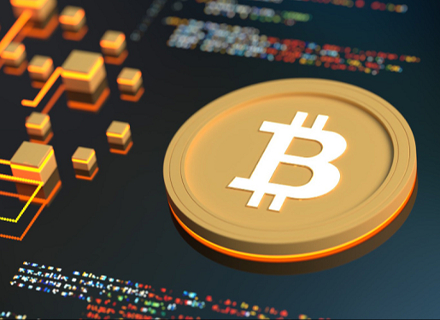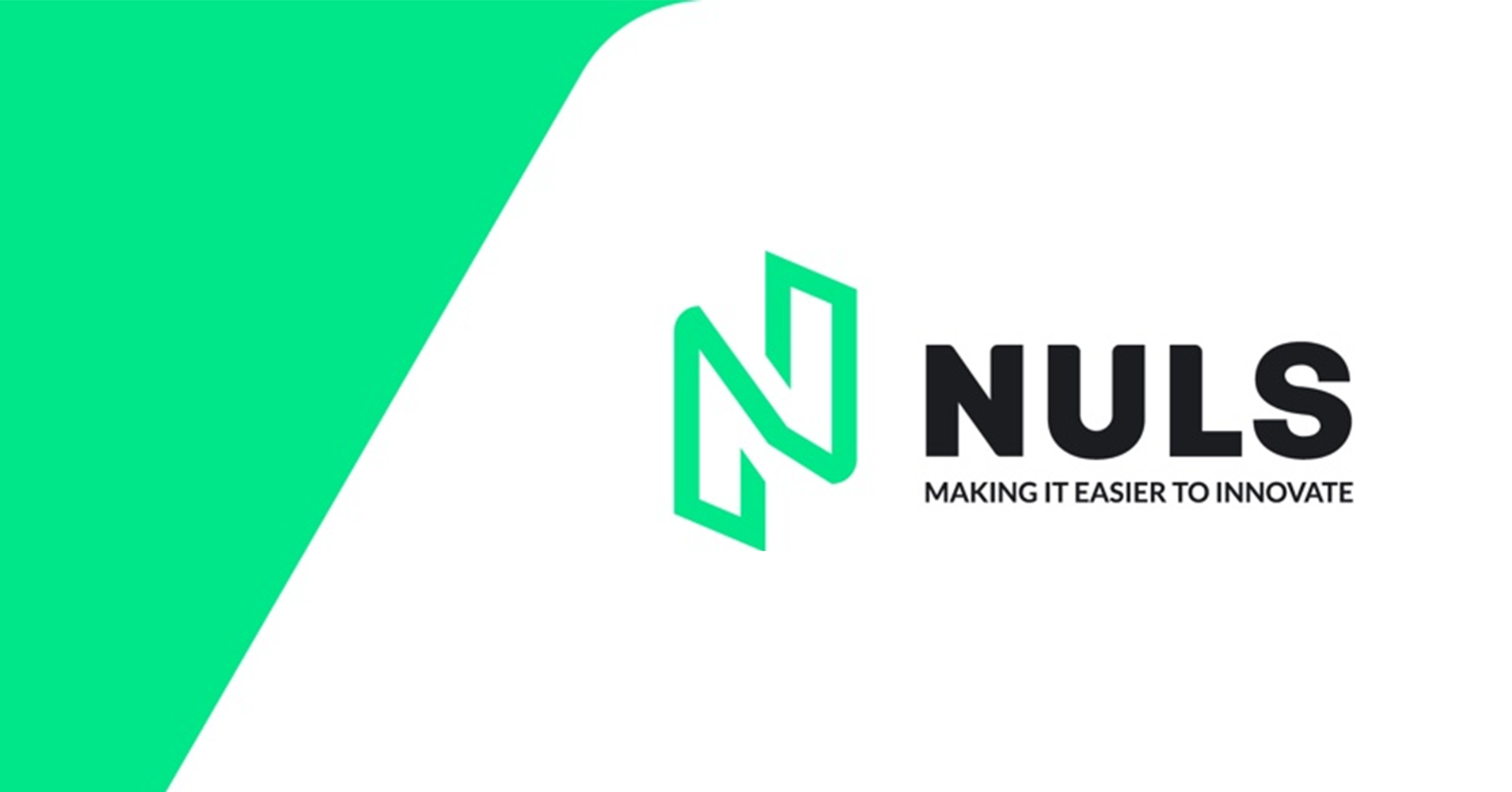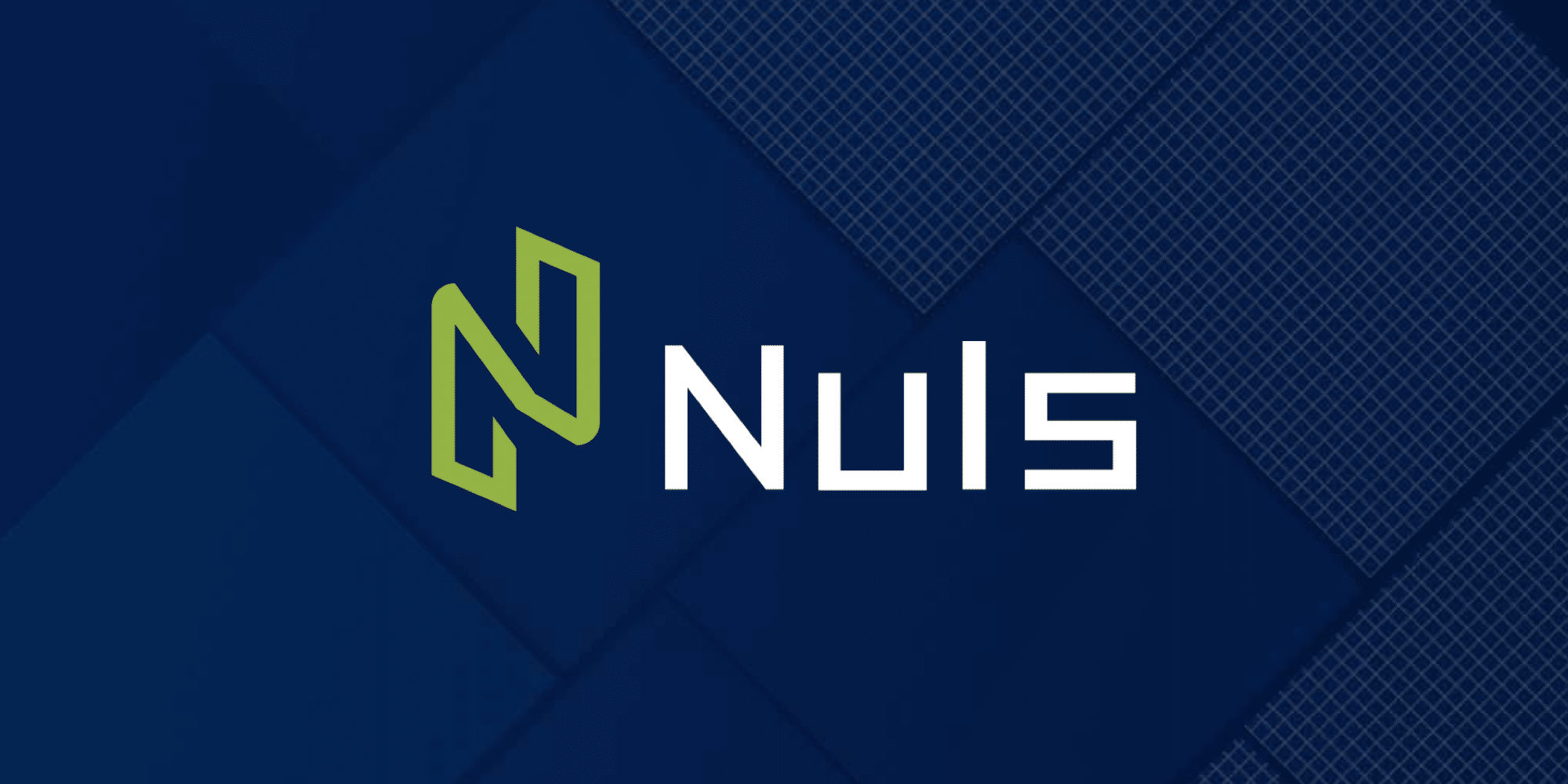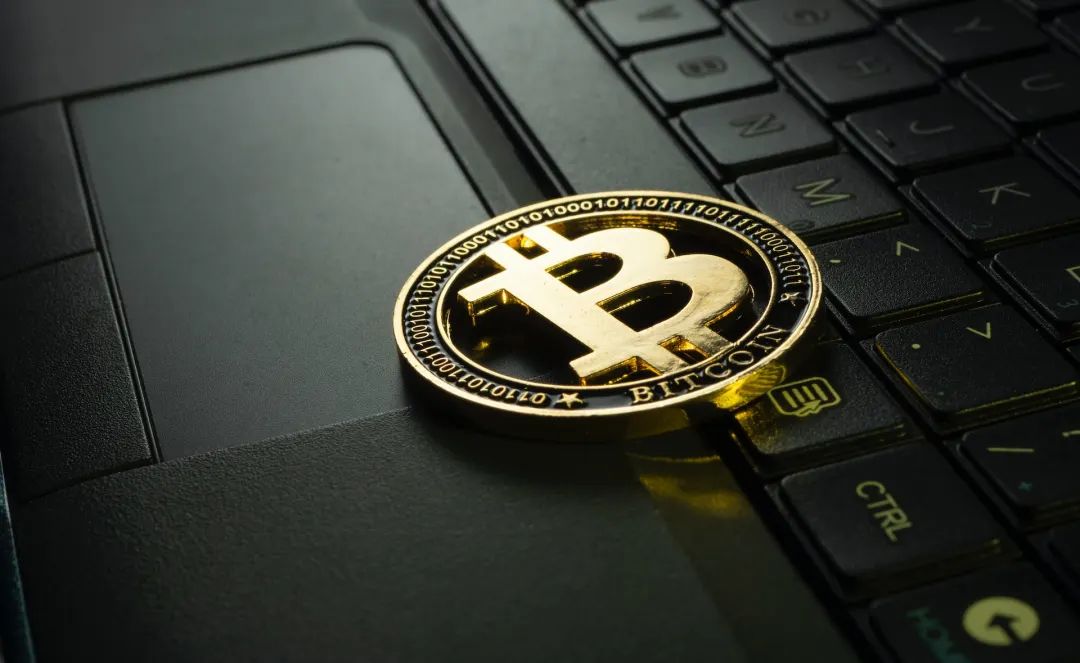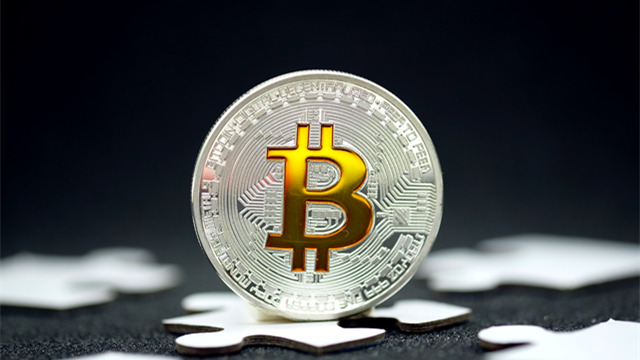Written by @G_Gyeomm
Comment by @JayLovesPotato
In a podcast featuring Kain, the founder of Synthetix & Infinex, content implying that Vitalik Buterin or the Ethereum Foundation has a (implicitly) negative view of DeFi was mentioned. This sparked critical reactions from the community, leading to various discussions about DeFi. As these discussions quite clearly show Vitalik's perspective on DeFi and provide various topics and insights related to DeFi, it's necessary to examine them closely.
1. Background - The Limitations of "Only DeFi" Pointed Out by Vitalik
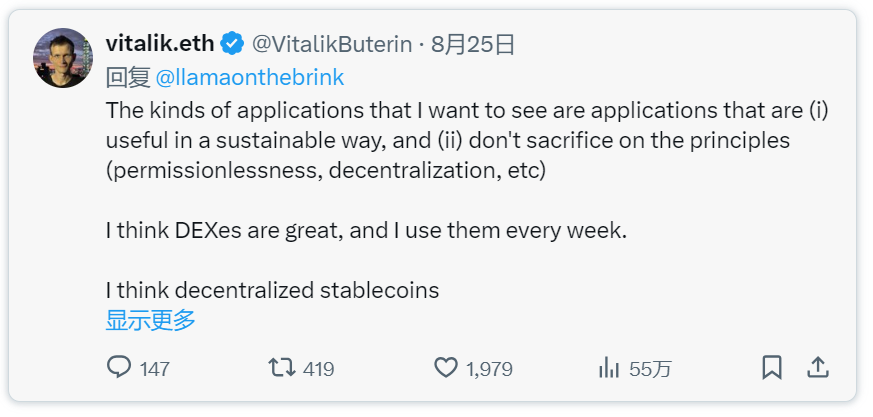
In response to a question about why Vitalik or the Ethereum Foundation seems to discourage DeFi despite most of ETH's value coming from its use as collateral in DeFi, Vitalik answered: The types of applications he wants are 1) those used usefully under sustainable methods, and 2) those that don't sacrifice principles like permissionlessness and decentralization. He highly values DEXes, decentralized stablecoins (e.g., RAI), and Polymarket, but "doesn't respect unsustainable protocols that only attract users through temporary factors." As an example, he mentioned that the 'Liquidity Farming' craze of 2021 didn't interest him as it fundamentally came from temporary token issuance. He emphasized the importance of questioning where DeFi's interest income comes from, who's on the other side of the trade, and who's paying the interest income.
He added that finance alone isn't enough, and it's important to find intersections between DeFi and technology. With today's rapid technological growth, many centralization risks (centralization of credit scores, social media, AI, BCI, etc.) are emerging, and decentralized finance is an important part in solving these problems. For example, decentralized financial infrastructure is needed because if a VPN's payment method doesn't ensure privacy, the VPN isn't anonymous. Similarly, decentralized social applications like Farcaster adopt some elements of decentralized finance as a sustainable monetization strategy instead of traditional advertising revenue models. In conclusion, he believes that the intersection between DeFi and decentralized technology is very important.
1.2 DeFi market is downstream of the existence of the ETH market
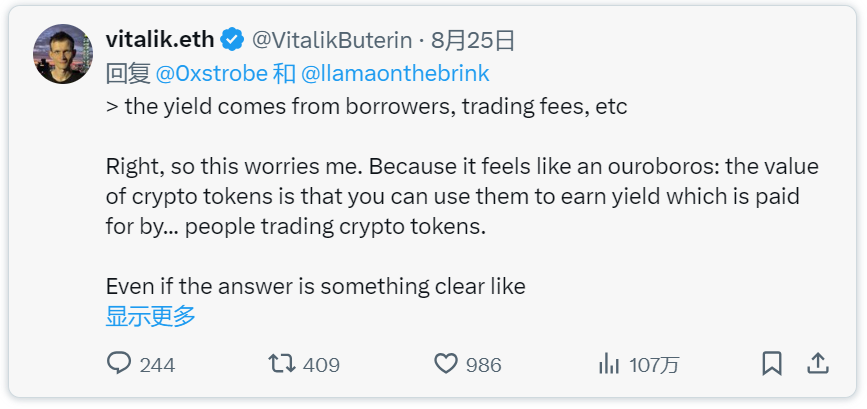
Following this discussion, a debate about the structural limitations of DeFi took place. In response to Vitalik's opinion, which seemed to limit DeFi to the liquidity farming of 2021, it was pointed out that 'DeFi' doesn't just mean the 'Ponzinomics' of 2021, but includes lending/borrowing like Aave, CDPs like RAI, synthetic assets, etc. The opinion was that these protocols' interest income comes from borrowers and trading fees, making them sustainable models and thus positive use cases of DeFi.
To this, Vitalik expressed concern about interest income coming only from borrowers and trading fees. Looking at the structure of DeFi, he said that the value of tokens comes from being able to earn interest income, but this structure is limited as the interest income is paid by people trading those tokens. For example, people receiving 8% APR in USD are paid by people paying 8% APR to leverage ETH 2x. The problem with this phenomenon is that it means the existence of the DeFi market is still dependent on the Ethereum market, implying that DeFi is fundamentally limited and can't be a factor in expanding crypto to another 10-100x adoption.
Summarizing Vitalik's opinions on DeFi from these various discussions:
- Sustainable DeFi protocols that don't just temporarily attract users, like the liquidity farming craze, are clearly meaningful.
- Nevertheless, DeFi alone is structurally limited in acting as a catalyst to expand crypto 10-100x. DeFi plays an important role as one of the components implementing decentralized technology, and it's important to bring value (interest) from outside, not dependent on the Ethereum economy.
2. Takeaway - About the Liquidity Mining and DeFi's Raison D'être
Regarding Vitalik's opinions, we can add our thoughts on various perspectives, from minor topics like the source of interest income and sustainable DeFi protocols, to major topics like the significance of DeFi's existence and its structural limitations.
2.1 Misunderstandings about Liquidity Mining
As Vitalik mentioned, it's crucial to check where the interest income guaranteed by DeFi protocols comes from to judge their sustainability. Especially during the 'Liquidity Mining' craze of 2021, the interest income provided by DeFi protocols to users was paid in governance tokens without separate value accumulation mechanisms. As a result, these governance tokens couldn't maintain stable prices, leading to decreased liquidity mining incentives and unsustainable operations. In fact, most DeFi protocols failed to prove subsequent Product-Market Fit (PMF) after their liquidity mining campaigns ended and lost retention, disappearing from the market.
However, this result doesn't mean that all DeFi protocols that conducted liquidity mining are unsustainable. Rather, DeFi protocols that relied solely on liquidity mining were phased out of the market because they didn't develop good enough products to grow sustainably. In other words, liquidity mining is not inherently part of a sustainable model, but a 'temporary' campaign to successfully bootstrap liquidity and users. Therefore, I think a more multifaceted evaluation of liquidity mining is needed.
Source: Gauntlet - Flywheel effect of Liquidity Mining
Looking back at the past liquidity mining craze, Compound, a lending/borrowing service, first started a liquidity mining campaign in June 2020. Following this, money market protocols like Aave and DEXes like Uniswap not only provided rewards to liquidity providers from loan interest and trading fees, but also distributed native tokens or tokens acquired through other channels (Uniswap distributed its share of $ARB airdrops received from Arbitrum's launch to liquidity providers) as additional incentives, securing users and liquidity steadily.
Source: Gauntlet - TVL(left) and Volume market share(right) for Incentivized pools of Uniswap
In fact, liquidity mining has shown high effectiveness in stably securing liquidity and users when launching initial DeFi protocols or expanding business areas to new chains. Accordingly, liquidity mining has established itself as an effective bootstrapping strategy through methods such as opening temporary Mining Pools that provide additional incentives. Besides, another reason why a multifaceted evaluation of liquidity mining is needed is that, compared to 'Pointnomics' that occurs opaquely off-chain or recent token distribution methods led by VCs with high FDV, liquidity mining is a relatively transparent way to distribute governance authority and effectively align the incentives of users contributing to the protocol's liquidity with those of the protocol.
In conclusion, it's true that oversupplied DeFi protocols without technological or product advantages only managed to attract temporary user interest through liquidity mining. However, various DeFi protocols such as Compound, Aave, Uniswap, and SushiSwap have maintained stable activity with sustainable models, solving the incentive problem for liquidity providers through interest provided by borrowers or trading fees after conducting liquidity mining as a bootstrapping strategy to solve the cold-start problem. Therefore, while Vitalik's opinion on the 2021 liquidity mining craze is somewhat valid, there's room for misunderstanding in judging the sustainability of liquidity mining and DeFi protocols, which is why I'm adding my opinion on this matter.
2.2 DeFi Is Enough on Its Own, Yet Expandable
Before discussing Vitalik's view that DeFi's existence can only be positioned as a subordinate structure to the Ethereum market, there are points to clarify regarding his controversial opinion.
First, he likens the structure of how DeFi interest is generated and received to 'ouroboros', the image of a snake eating its own tail. While this might be seen as expressing concern about the stability of interest sources arising from lending and borrowing, the flow of interest income where borrowers provide interest to lenders is not significantly different from the mechanism of the banking system. Therefore, it is thought that he did not express concern about the interest payment ability or financial soundness of money market protocols like Aave and Spark. Furthermore, as evident from the fact that he mentioned the oracle-reliant Polymarket as a positive use case, and acknowledged the practical aspects of USDC despite its censorship risks, it doesn't seem that he expressed a negative view of DeFi because he is a 'pure' DeFi advocate.
The core of the message seems to be highlighting the importance of DeFi as a financial infrastructure supporting decentralized technology or applications, as DeFi is limited to interactions with intrinsic demand and supply within the Ethereum economy. It also seems reasonable to view it as an argument that we should leave open the possibility for something that can drive more widespread adoption of crypto, beyond the current Ethereum network usage which is biased towards DeFi.
From that perspective, one can agree with his opinion of not limiting the usability of Ethereum, and further blockchain, to just DeFi. Of course, DeFi itself provides important value in that it can greatly lower the high entry barriers of traditional financial infrastructure. Moreover, the characteristics of DeFi that allow building money legos through interoperability between various types of DeFi protocols, from Money Markets and DEXes to derivative products like synthetic assets and Yield markets, demonstrate the irreplaceable significance of DeFi's existence in that it has unique value not found in traditional financial infrastructure.
Nevertheless, it's worth remembering that even in traditional markets, 'finance' was originally a field where only a specialized minority had access and engaged in economic interactions. Then, when expecting blockchain to be adopted by more users, it's also difficult to see DeFi as its catalyst. This is one of the reasons why consumer-oriented applications like Polymarket or Farcaster, which are easily accessible and have universal usability, are receiving much attention recently compared to DeFi, and why it's not meaningless to point out that DeFi's existence inevitably has a structure subordinate to the Ethereum economy.
2.3 Conclusion: A Thought-Provoking Challenge for Ethereum and DeFi
It's a well-known fact that opinions on Vitalik are divided. At the extremes, these evaluations can be categorized into two views: one that highly regards him as the founder of a 'neutral' Ethereum network and an advocate for privacy and decentralized technology, and another that sees him as an idealist who deliberately ignores market logic and the practical demands of the community. Similarly, his recent statements about DeFi, which we discussed in today's article, are also causing divided opinions within the community.
In the growth process of Layer 1 blockchains, it's common to see CEOs or Founders actively communicating with the community, mentioning applications within the ecosystem, and highlighting updates. This is a familiar pattern easily observed in most Layer 1 projects such as Solana, Monad, Sui, and Injective. Given this context, the stance of a Founder seemingly expressing negative opinions about DeFi, which accounts for 1/3 of the network fees generated on Ethereum over a year, could be enough to raise concerns in the community. This is particularly true in a situation where there are already worries about Ethereum's status due to ecosystem fragmentation caused by the L2-centric roadmap and reduced ETH deflation. In this light, he might be underestimating the importance of DeFi applications that are driving the ecosystem.
However, it appears that rather than simply expressing a negative view on DeFi, he is proposing a direction regarding the role of DeFi in the expansion of a blockchain network and its ideal development path. While not everyone needs to agree with this message, it can be said that this discussion is meaningful in that it has at least thrown a constructive topic of debate to the crypto market with a consistent direction.
3. Others’ Opinion
3.1 Jay from Four Pillars
Vitalik pointed out that many DeFi experiments to date have primarily focused on endogenous on-chain assets, resulting in the proliferation of worthless assets and often devolving into zero-sum games. Also, he emphasized the importance of merging of off-chain and on-chain grammar and finding intersections with real-world technologies.
I believe this statement is closely related to a significant turning point for the broader adoption of blockchain. For instance, enabling financial activities on the blockchain through infrastructures optimized for onboarding and interacting with specific assets, such as @plumenetwork ’s RWAFi or @StoryProtocol ’s IPFi, aligns closely with the very essence of blockchain: facilitating trustworthy interactions with diverse real-world assets.
However at the same time, I hope this perspective does not lead to the misjudgment that all various Web3-native experiments are meaningless. Especially in the DeFi sector, these experiments have served as vital “empirical case studies,” exploring the diverse possibilities of programmable assets. The rise and fall of numerous DeFi projects with different strategies have provided valuable lessons on how to implement creative incentive mechanisms tailored to their specific goals, whether the outcomes were positive or negative. In short, while finding those intersections is essential, we shouldn’t be confined to them. In other words, rather than focusing solely on the intersections themselves, we should concentrate on the process of validating external validity to find more effective intersections through ongoing Web3 native experiments.
4. Resource
Related Articles, News, Tweets etc.
- https://x.com/VitalikButerin/status/1827642283560144916
- https://x.com/llamaonthebrink/status/1827344864196903056
- https://www.youtube.com/watch?v=GPd3uWEVnSg









